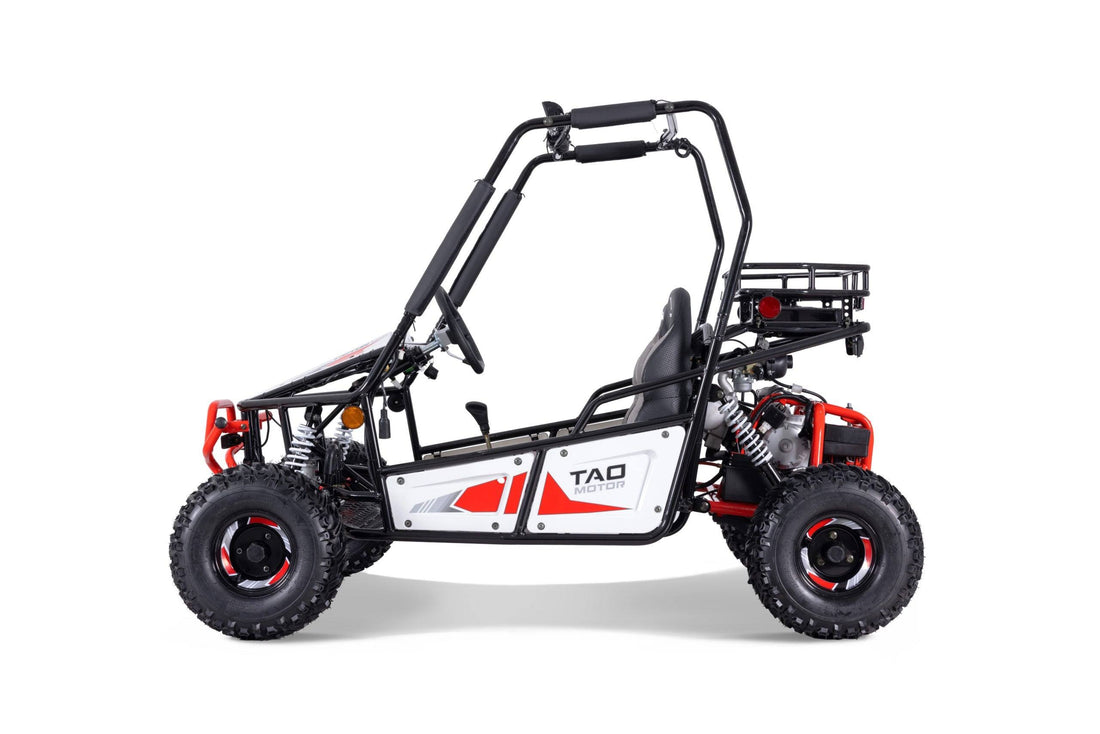
Basic Routine Maintenance Schedule for 4 Stroke Go Karts
Share
Basic Routine Maintenance Schedule for 4 Stroke Go Karts
Regular maintenance is key to keeping your 4 stroke go kart in top condition. By following a basic routine maintenance schedule, you can ensure that your go kart runs smoothly and prolong its lifespan. Here is a comprehensive guide to help you maintain your 4 stroke go kart:
1. Check the Engine Oil
Regularly check the engine oil level and quality. Low or dirty oil can cause engine damage. Refer to the manufacturer's manual for the recommended oil type and frequency of oil changes. Change the oil as per the guidelines to maintain optimal engine performance.
2. Clean or Replace the Air Filter
The air filter prevents dirt and debris from entering the engine. Over time, it can become clogged and restrict airflow. Clean or replace the air filter as recommended by the manufacturer to ensure proper engine combustion and performance.
3. Inspect the Spark Plug
The spark plug ignites the fuel-air mixture in the engine cylinder. Regularly check the spark plug for signs of wear and carbon buildup. Replace the spark plug if necessary, following the manufacturer's instructions.
4. Check and Adjust the Tire Pressure
Proper tire pressure is crucial for optimal handling and performance. Check the tire pressure regularly and adjust it according to the manufacturer's recommendations. This will also help extend the life of your tires.
5. Lubricate Moving Parts
Lubricate the moving parts such as the chain, throttle, and brake cables to reduce friction and ensure smooth operation. Use lubricants recommended by the manufacturer and follow the proper lubrication intervals.
6. Inspect the Brakes
Regularly inspect the brake system for wear and tear. Check the brake pads, brake lines, and brake fluid level. Replace any worn-out brake components and bleed the brake system if necessary. Properly functioning brakes are essential for safety.
7. Check the Battery
If your go kart has a battery, inspect it regularly for corrosion, loose connections, and proper voltage. Clean the battery terminals and ensure a secure connection. If the battery is not maintenance-free, check and refill the electrolyte levels if needed.
8. Inspect the Frame and Suspension
Inspect the frame for any cracks or damage. Check the suspension components for wear and tear. Replace any damaged parts to maintain the structural integrity and proper handling of your go kart.
9. Clean and Store Properly
After each use, clean your go kart thoroughly to remove dirt, debris, and moisture that can cause corrosion. Store your go kart in a dry and secure location, away from extreme temperatures and direct sunlight.
10. Check the Fuel System
Regularly inspect the fuel system for any leaks or blockages. Check the fuel lines, fuel filter, and fuel tank. Clean or replace any clogged filters and repair any leaks to ensure proper fuel delivery and prevent engine damage.
11. Inspect the Drive Belt
If your go kart is belt-driven, inspect the drive belt for signs of wear, cracks, or fraying. Replace the drive belt if necessary to maintain optimal power transfer and performance.
12. Check the Cooling System
Inspect the radiator, coolant hoses, and coolant level regularly. Clean any debris from the radiator fins and ensure the coolant is at the proper level. Overheating can cause engine damage, so a well-functioning cooling system is essential.
13. Inspect the Exhaust System
Regularly check the exhaust system for any leaks, loose connections, or damage. Ensure that the exhaust is securely attached and functioning properly. A damaged or faulty exhaust system can affect engine performance and noise levels.
14. Check the Electrical System
Inspect the wiring, switches, and electrical components regularly. Look for any loose connections, frayed wires, or signs of damage. Repair or replace any faulty electrical components to ensure proper functioning of the lights, ignition, and other electrical systems.
15. Test the Ignition System
Regularly test the ignition system to ensure a strong spark. Check the ignition coil, ignition switch, and spark plug wires for any issues. A weak or inconsistent spark can affect engine performance and reliability.
16. Inspect the Steering System
Regularly inspect the steering system for any play or looseness. Check the steering wheel, tie rods, and steering rack for wear and proper alignment. Make any necessary adjustments or replacements to maintain precise steering control.
17. Check the Clutch and Transmission
If your go kart has a clutch and transmission system, inspect them regularly for any signs of wear or damage. Lubricate the clutch and transmission components as recommended by the manufacturer to ensure smooth operation.
18. Test the Brakes
Regularly test the brakes to ensure they are functioning properly. Perform brake performance tests in a safe and controlled environment. If you notice any issues with braking performance, have them inspected and repaired by a qualified professional.
19. Inspect the Suspension Bushings
Check the suspension bushings for wear and tear. Replace any worn-out bushings to maintain proper suspension performance and stability.
20. Follow the Manufacturer's Manual
Lastly, always refer to the manufacturer's manual for specific maintenance guidelines and recommended service intervals. Each go kart may have unique requirements, so it's important to follow the instructions provided by the manufacturer.
21. Consult with Professionals
If you are unsure about any maintenance procedures or if you encounter any major issues with your go kart, it's always best to consult with professionals. They have the expertise and experience to diagnose and fix complex problems.
22. Keep a Maintenance Record
Maintaining a record of all the maintenance and repairs performed on your go kart is essential. This record will help you track the maintenance history, identify patterns, and ensure that all necessary tasks are completed.
23. Stay Up-to-Date with Safety Guidelines
It's important to stay updated with the latest safety guidelines for go kart operation and maintenance. Regularly check for any safety recalls or bulletins issued by the manufacturer. Following proper safety protocols will help ensure a safe and enjoyable riding experience.
24. Inspect Bearings and Bushings
Inspect the bearings and bushings in the wheels, suspension, and other moving parts. Replace any worn-out or damaged bearings to maintain smooth and reliable performance.
25. Check the Drive Chain
If your go kart has a drive chain, inspect it regularly for proper tension and lubrication. Ensure that the chain is properly aligned and not excessively worn. Replace the chain if necessary to prevent drivetrain issues.
26. Test the Throttle and Brake Response
Regularly test the throttle and brake response to ensure they are functioning properly. Check for any delays or inconsistencies in the response. Adjust or repair the throttle and brake systems as needed.
27. Inspect the Fuel Tank
Inspect the fuel tank for any signs of damage or leaks. Ensure that the fuel cap is properly sealed. Replace any damaged or faulty fuel tanks to prevent fuel leaks and potential hazards.
28. Winterize Your Go Kart
If you live in a region with cold winters, it's important to winterize your go kart. This involves preparing it for long-term storage by draining the fuel, lubricating the engine, and protecting it from moisture and corrosion.
29. Monitor Performance and Handling
Pay attention to any changes in performance or handling characteristics of your go kart. If you notice any unusual vibrations, noises, or decreased performance, investigate and address the issue promptly to prevent further damage.
30. Stay Informed about Upgrades and Recalls
Stay informed about any upgrades or recalls related to your go kart model. Manufacturers may release updates or recall certain components for safety or performance reasons. Keeping up-to-date will help you maintain the optimal performance and safety of your go kart.
By following this comprehensive routine maintenance schedule, you can keep your 4 stroke go kart running smoothly and enjoy endless hours of fun and excitement. Remember, regular maintenance not only enhances performance but also ensures your safety on the track.
